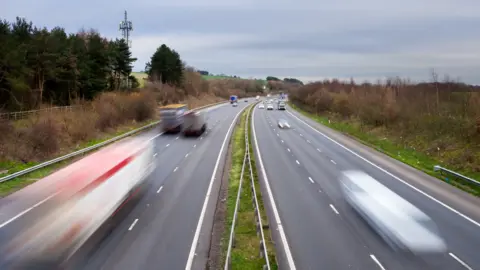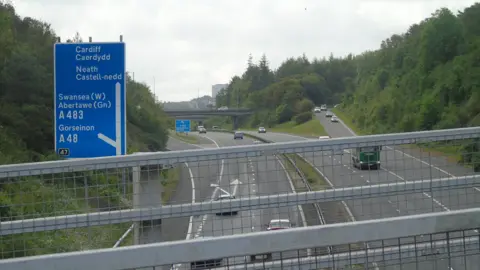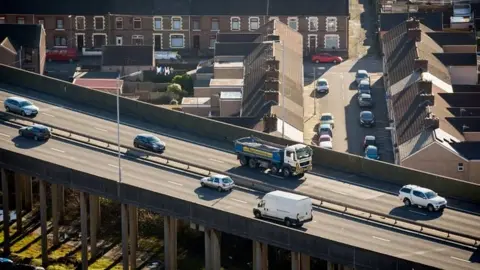M4 and us: How traffic is set to rise on south Wales motorway
 Getty Images
Getty ImagesTraffic along the M4 in Wales is set to increase by nearly 38% over the next 30 years, projections by the Department for Transport show.
Statistics on average vehicle use show the busiest stretch is currently between Newport and Cardiff.
But the biggest proportional rise in traffic in the last 17 years has been west of Swansea near Penllergaer.
It is estimated that as traffic rises, speed at peak times will slow to just over 52mph.
The removal of the Severn tolls is estimated by the Department for Transport at leading to a 23% rise in traffic in 2019 on top of the long term increase - running at 4% a year since 2014.
The Welsh Government said its traffic modelling shows that by the Brynglas tunnels this increase would filter down to around 7%, dropping to a 2% increase before Cardiff.
A quick M4 timeline
Most of the M4 was built over a 20-year period from 1966. From the building of the first Severn Bridge, it was developed in sections, as a series of by-passes for towns and cities, starting with Port Talbot, then Newport to take traffic away from the route of the old A48 - slow and clogged with vehicles - which it shadowed.
Swansea, Bridgend and Cardiff followed in the 1970s - but not without delays due to cutbacks. The final pieces in the jigsaw were the sections at Briton Ferry and the second Severn Bridge in the mid 1990s.
With businesses and housing growing around it, the years since have been dominated by the question of how to deal with pinch points along the M4 corridor. The debate over the new motorway around Newport - effectively a relief road for a relief road - started in 1994 and was finally abandoned in June.
But beyond Newport there are still issues along the whole motorway - questions of not only how we will travel by car in future, but how our public transport system might play into solutions.

Which part of the M4 in Wales is the busiest?
Not surprisingly, junction 27 at High Cross near Newport is the busiest stretch - with nearly 122,000 vehicles a day. Just behind is the stretch around junction 28 at Tredegar Park (119,481 vehicles a day). Around 90,000 vehicles use the two Severn crossings on an average day.
But the M4 junction which has seen the biggest rise in daily traffic over the last 17 years is 47 at Swansea West. Back in 2000, there were an average 40,724 vehicles passing there; by 2017 it had jumped 78% to 72,378 vehicles a day.
The end of the motorway at Pont Abraham in Carmarthenshire, while seeing the least traffic - an average 46,950 vehicles a day according to Department of Transport figures - has still seen a 51% increase on 2000.

What is expected to happen to traffic in the future?
The Department for Transport projects future potential traffic along the whole of the M4 in Wales between now and 2050.
It uses models which factor in how the economy might do, migration levels, fuel costs and the shift to low emission vehicles.
Currently there are 2.3bn miles driven by vehicles along the M4 in Wales.
The projections are for this to increase by nearly 38% to 3.17bn miles in the next 30 years or so.
When you look at particular vehicles - the number of light vans using the motorway is projected to rise 40%.
As for carbon emissions, with 25% of vehicles assumed to be electric by 2050, there is predicted to be a 22% fall along the M4.
 Getty Images
Getty ImagesWhat about traffic speed?
At the moment, traffic during the morning peak along the M4 travels at an average 60mph. With the increase in traffic forecast, this could fall to just over 52mph by 2050 - a bigger fall than forecast for England and Wales combined and the second slowest average speed next to the east of England. The evening peak is slightly faster. Across all times of day, the average speed is predicted to fall from 66.4mph to 60.5mph.
What will this mean for delays?
There is a calculation of delays in seconds for every mile of road. In Wales, at the moment there are around 12 seconds lost per mile of road during the morning peak - around half the average delay across England and Wales. But while less time is lost on the motorway (10.6 seconds per mile), this is second worst of any area. And rush hour delays are projected to get worse - to 18.4 seconds per mile on the motorway in Wales by 2050.
